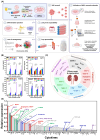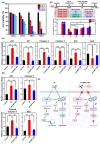Hydrogel-Mediated Local Delivery of Induced Nephron Progenitor Cell-Sourced Molecules as a Cell-Free Approach for Acute Kidney Injury
- PMID: 39408943
- PMCID: PMC11477367
- DOI: 10.3390/ijms251910615
Hydrogel-Mediated Local Delivery of Induced Nephron Progenitor Cell-Sourced Molecules as a Cell-Free Approach for Acute Kidney Injury
Abstract
Acute kidney injury (AKI) constitutes a severe condition characterized by a sudden decrease in kidney function. Utilizing lineage-restricted stem/progenitor cells, directly reprogrammed from somatic cells, is a promising therapeutic option in personalized medicine for serious and incurable diseases such as AKI. The present study describes the therapeutic potential of induced nephron progenitor cell-sourced molecules (iNPC-SMs) as a cell-free strategy against cisplatin (CP)-induced nephrotoxicity, employing hyaluronic acid (HA) hydrogel-mediated local delivery to minimize systemic leakage and degradation. iNPC-SMs exhibited anti-apoptotic effects on HK-2 cells by inhibiting CP-induced ROS generation. Additionally, the localized biodistribution facilitated by hydrogel-mediated iNPC-SM delivery contributed to enhanced renal function, anti-inflammatory response, and renal regeneration in AKI mice. This study could serve as a 'proof of concept' for injectable hydrogel-mediated iNPC-SM delivery in AKI and as a model for further exploration of the development of cell-free regenerative medicine strategies.
Keywords: cell-free regenerative medicine; induced nephron progenitor cells; injectable hydrogel.
Conflict of interest statement
The authors declare that they have no known competing financial interests or personal relationships that could have appeared to influence the work reported in this paper.
Figures





Similar articles
-
Delivery of interleukin-10 via injectable hydrogels improves renal outcomes and reduces systemic inflammation following ischemic acute kidney injury in mice.Am J Physiol Renal Physiol. 2016 Aug 1;311(2):F362-72. doi: 10.1152/ajprenal.00579.2015. Epub 2016 Mar 9. Am J Physiol Renal Physiol. 2016. PMID: 26962109 Free PMC article.
-
NADPH oxidase 4 promotes cisplatin-induced acute kidney injury via ROS-mediated programmed cell death and inflammation.Lab Invest. 2018 Jan;98(1):63-78. doi: 10.1038/labinvest.2017.120. Epub 2017 Nov 6. Lab Invest. 2018. PMID: 29106395
-
Delivery of EPC embedded in HA-hydrogels for treatment of acute kidney injury.Biomatter. 2013 Jan-Mar;3(1):e23284. doi: 10.4161/biom.23284. Epub 2013 Jan 1. Biomatter. 2013. PMID: 23507925 Free PMC article. Review.
-
Mitochondria targeted peptide SS-31 prevent on cisplatin-induced acute kidney injury via regulating mitochondrial ROS-NLRP3 pathway.Biomed Pharmacother. 2020 Oct;130:110521. doi: 10.1016/j.biopha.2020.110521. Epub 2020 Jul 24. Biomed Pharmacother. 2020. PMID: 32717631
-
Regenerative pharmacology for the treatment of acute kidney injury: Skeletal muscle stem/progenitor cells for renal regeneration?Pharmacol Res. 2016 Nov;113(Pt B):802-807. doi: 10.1016/j.phrs.2016.03.014. Epub 2016 Mar 18. Pharmacol Res. 2016. PMID: 27001227 Review.
References
MeSH terms
Substances
Grants and funding
LinkOut - more resources
Full Text Sources
Medical
Miscellaneous

